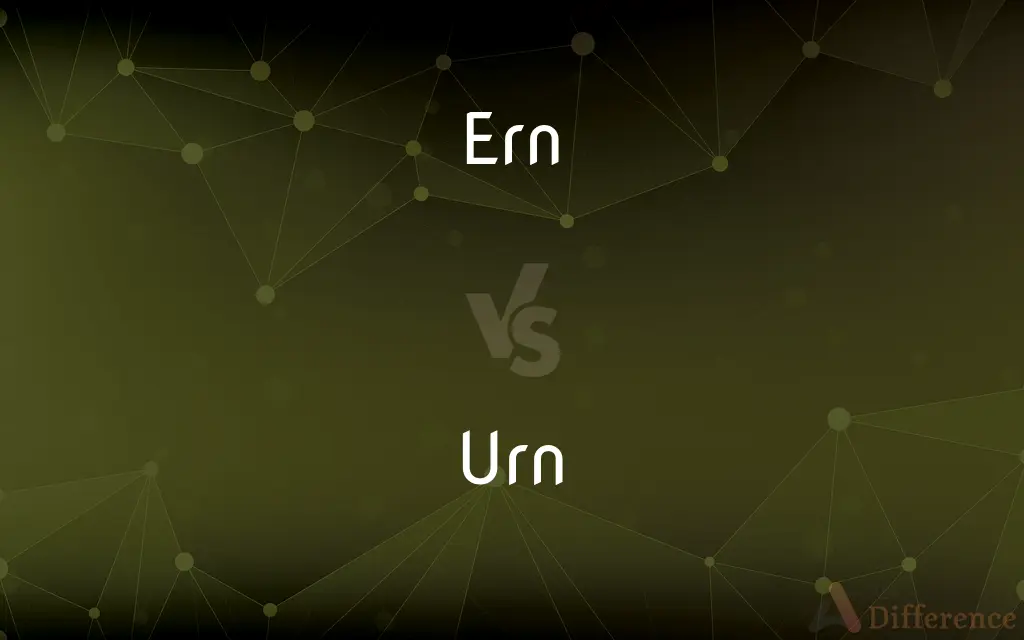Ern vs. Urn — What's the Difference?
Edited by Tayyaba Rehman — By Maham Liaqat — Updated on March 20, 2024
Ern refers to a sea eagle, known for its strength and size, while an urn is a vase, often used for ashes or decorative purposes.

Difference Between Ern and Urn
Table of Contents
ADVERTISEMENT
Key Differences
Ern is a term often used to refer to the white-tailed sea eagle, a large bird of prey known for its impressive wingspan and habitat near coastal areas. These birds are revered for their strength and hunting prowess, typically feeding on fish and small mammals. Whereas, an urn is a type of vase with a narrow neck and a rounded body, traditionally used to store the ashes of the deceased in many cultures but also serves as a decorative element or for other purposes like holding flowers.
Ern embodies the majesty and freedom of nature, soaring high in the skies and symbolizing power and resilience. On the other hand, an urn represents the human connection to tradition, memory, and the past. It holds sentimental or ceremonial significance, often symbolizing respect for those who have passed.
While ern is a living creature, interacting with its environment, and playing a role in the ecosystem, an urn is an inanimate object crafted by human hands. The ern’s existence reflects natural processes and ecological balance, whereas the urn's presence reflects human artistry and cultural practices.
The ern has adapted to a variety of environments but prefers coastal regions where it can easily find food. Its life cycle includes mating, nesting, and raising young, ensuring the species' continuation. Conversely, the urn, as a crafted object, does not undergo a life cycle but may have a lifecycle in terms of usage, from being actively used in ceremonies to possibly being displayed or stored as an heirloom.
Ern, as a symbol, can vary in meaning across different cultures, often representing strength, purity, and freedom. In contrast, the urn’s symbolic meaning is more universally understood as a representation of mortality, remembrance, and the final resting place of loved ones, showcasing how both hold significant yet distinct symbolic values in human society.
ADVERTISEMENT
Comparison Chart
Nature
Living bird of prey
Inanimate object
Symbolism
Strength, freedom, purity
Mortality, remembrance, tradition
Usage
Natural role in the ecosystem
Holds ashes, decorative purposes
Environment
Prefers coastal areas for habitat and hunting
Used in homes, ceremonies, and as memorials
Human Connection
Represented in culture and mythology
Integral to various cultural and memorial practices
Compare with Definitions
Ern
Often symbolizes strength and freedom.
In local folklore, the ern is a guardian of the seas, embodying freedom.
Urn
A vase with a narrow neck and rounded body, often used for ashes.
The family placed the urn on the mantle, in memory of their loved one.
Ern
A large bird of prey known as the white-tailed sea eagle.
The ern soared above the coastline, scanning the water for fish.
Urn
Features in many cultural and religious practices.
In the ceremony, the urn was used to symbolize the spiritual journey after gone.
Ern
Known for their impressive hunting skills and monogamous nature.
The pair of erns worked together to feed their young in the nest.
Urn
Represents remembrance, mortality, and the past.
The urn symbolized the family's enduring love and the memories shared.
Ern
Prefers coastal regions and open water for hunting.
We spotted an ern nesting near the cliff, overlooking the sea.
Urn
Made from various materials such as ceramic, metal, or stone.
The urn, crafted from marble, had intricate designs etched into its surface.
Ern
Primarily feeds on fish and small mammals.
The ern dived swiftly, catching a fish with its talons.
Urn
Used for storing ashes or as a decorative element.
Apart from holding ashes, the urn served as a focal point in the room.
Ern
A sea eagle, especially Haliaeetus albicilla of Europe.
Urn
An urn is a vase, often with a cover, with a typically narrowed neck above a rounded body and a footed pedestal. Describing a vessel as an "urn", as opposed to a vase or other terms, generally reflects its use rather than any particular shape or origin.
Ern
Alternative spelling of erne
Urn
A tall, rounded vase with a stem and base, especially one used for storing the ashes of a cremated person.
Ern
To run; flow.
Urn
A large metal container with a tap, in which tea or coffee is made and kept hot, or water for making such drinks is boiled
A tea urn
Ern
To (cause to) coagulate; curdle (milk) by adding rennet and applying heat.
Urn
Place in an urn.
Ern
To stir with strong emotion; grieve; mourn.
Urn
A vase of varying size and shape, usually having a footed base or pedestal, especially a lidded vase used to hold the ashes of one who has been cremated.
Ern
To pain; torture.
Urn
A closed metal vessel having a spigot and used for warming or serving tea or coffee.
Ern
(of the eyes) To cause to water; smart.
Urn
(Botany) The spore-bearing part of a moss capsule.
Ern
A sea eagle, esp. the European white-tailed sea eagle (Haliæetus albicilla).
Urn
A vase with a footed base.
Ern
To stir with strong emotion; to grieve; to mourn. [Corrupted into yearn in modern editions of Shakespeare.]
Urn
A metal vessel for serving tea or coffee.
Ern
Bulky grayish-brown eagle with a short wedge-shaped white tail; of Europe and Greenland
Urn
A vessel for the ashes or cremains of a deceased person.
Urn
(figurative) Any place of burial; the grave.
Urn
A measure of capacity for liquids, containing about three gallons and a half, wine measure. It was half the amphora, and four times the congius.
Urn
(botany) A hollow body shaped like an urn, in which the spores of mosses are contained; a spore case; a theca.
Urn
(transitive) To place in an urn.
Urn
Fig.: Any place of burial; the grave.
Or lay these bones in an unworthy urn,Tombless, with no remembrance over them.
Urn
A measure of capacity for liquids, containing about three gallons and a haft, wine measure. It was haft the amphora, and four times the congius.
Urn
A hollow body shaped like an urn, in which the spores of mosses are contained; a spore case; a theca.
Urn
A tea urn. See under Tea.
Urn
To inclose in, or as in, an urn; to inurn.
When horror universal shall descend,And heaven's dark concave urn all human race.
Urn
A large vase that usually has a pedestal or feet
Urn
A large pot for making coffee or tea
Common Curiosities
Why are urns important in cultural practices?
Urns hold significant cultural and sentimental value, often used in ceremonies to honor and remember the deceased.
How does the ern contribute to the ecosystem?
The ern plays a role in controlling the population of fish and small mammals, contributing to ecological balance.
Do erns have any natural predators?
Adult erns have few natural predators due to their size, but eggs and young can be threatened by other birds and mammals.
Are urns made only for holding ashes?
While traditionally used for ashes, urns can also be decorative or hold other items.
What is an urn used for?
An urn is used to store the ashes of the deceased, though it can also serve decorative purposes.
Can an ern symbolize anything?
Yes, erns can symbolize strength, purity, and freedom across various cultures.
What materials are urns typically made from?
Urns are made from a variety of materials including ceramic, metal, wood, and stone.
Can urns be personalized?
Yes, urns can be personalized with engravings, designs, and even bespoke shapes to reflect the deceased's personality or family wishes.
What is an ern?
An ern is a large bird of prey, specifically a white-tailed sea eagle, known for its size and hunting ability.
How long have urns been used by humans?
Urns have been used for thousands of years, with their use dating back to ancient civilizations.
Is the design of an urn important?
Yes, the design of an urn can be important for aesthetic, cultural, and personal reasons.
How do erns hunt for their food?
Erns hunt by soaring above water and diving to catch prey with their talons.
What is the significance of an urn in a funeral?
In a funeral, an urn serves as a vessel for the ashes and a symbol of the person's life and memories cherished by loved ones.
Where can erns be found?
Erns are primarily found in coastal areas and near large bodies of water where they hunt.
Can erns be seen in urban areas?
While erns prefer natural habitats, they can occasionally be seen in urban areas near water.
Share Your Discovery

Previous Comparison
Loads vs. Lots
Next Comparison
Blindsight vs. BlindsideAuthor Spotlight
Written by
Maham LiaqatEdited by
Tayyaba RehmanTayyaba Rehman is a distinguished writer, currently serving as a primary contributor to askdifference.com. As a researcher in semantics and etymology, Tayyaba's passion for the complexity of languages and their distinctions has found a perfect home on the platform. Tayyaba delves into the intricacies of language, distinguishing between commonly confused words and phrases, thereby providing clarity for readers worldwide.
















































